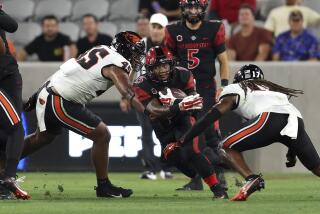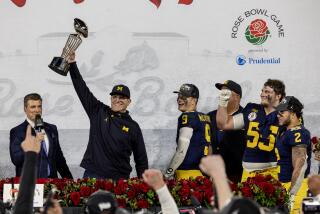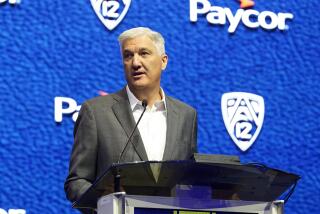USC, UCLA score big in Pac-12 alignment
The soon-to-be Pacific 12 Conference set out Thursday to prove a house divided can stand.
There had been plenty of nervousness in the weeks and months since Colorado and Utah accepted invitations. Just how was this configuration going to be split?
Now we know, and it worked out fine â especially for the Los Angeles schools.
University presidents emerged from meetings in San Francisco on Thursday in unanimous agreement that the conference will divide into two, six-team divisions of North and South.
Pretty simple, huh?
This arrangement is only for football and starts next season. There will be no divisions (at least for now) for all other Pac-12 sports.
The Pac-12 North: California, Stanford, Oregon, Oregon State, Washington and Washington State.
The Pac-12 South: USC, UCLA, Arizona, Arizona State, Colorado and Utah.
There will be a Pac-12 championship game, beginning in December 2011, played on the home field of the team with the best conference record.
This was an idea Commissioner Larry Scott floated last year â an NFL-type reward for on-field performance.
The big winners in the new Pac-12 are UCLA and USC, which fought for, and won, keeping Cal and Stanford as every-season opponents in the new nine-game conference format.
USC has played Cal and Stanford more times than it has played UCLA.
âFrom USCâs standpoint, weâre quite pleased,â USC Athletic Director Pat Haden said Thursday. ââ¦Theyâve preserved the traditional rivalries. Not just ours, everybodyâs. Itâs a new day, weâre happy, and bring on the Pac-12.â
How it will work: USC and UCLA will play five games in their own division and four crossover games against the North. Two of those games, though, will always be against Cal and Stanford.
USC and UCLA will play other North teams once every other year. The Northwest schools seemingly get the short end because they will not make annual trips to Los Angeles, where all four schools heavily recruit. The trade-off will be increased payouts in a new revenue-sharing plan starting in 2012.
âOur rivalries have been kept completely intact,â Scott said.
The other big winners are Colorado and Utah, which join forces with the Los Angeles schools in the South without paying an initiation fee.
Scott, in his second year as commissioner, sees this as the first giant step in rebranding the Pac-12 on a national, even international, scale. He said Thursday that a Pac-12 network is still very much in the works.
The key to the future will be new television negotiations that begin early next year. Scott now has a blueprint to take to the table and figures to at least double the roughly $60 million the conference earns annually in football revenue.
The conference divides NCAA basketball money equally, but its revenue-sharing plan in football is weighted toward schools â UCLA and USC â that make more television appearances.
Starting in 2012, conference schools will share money equally if annual total conference revenue exceeds $170 million. Anything less and USC and UCLA will receive an additional $2 million.
The new conference configuration is not perfect â no plan could satisfy everyone. There was division among the conferenceâs athletics directors about the North-South alignment, and the vote forwarded to the league presidents was only 7-5 in favor.
The chancellors, though, voted unanimously to adopt the new plan.
âThe ADs are probably not unanimous on anything,â Arizona State President Michael Crow said.
You can question how the Pac-10 got to be the Pac-12, especially when it was supposed to be the Pac-16 before Texas nixed the deal last June.
That would have been a more interesting, seamless confederation, with the old Pac-8 reforming in the West and the Arizona schools joining half the Big 12 in the East.
The Pac-12 was the fallback plan, and Thursday the plan was unveiled.
Scott called it âtruly an historic dayâ for the league.
Not as historic as it might have been, perhaps, but historic enough.
More to Read
Go beyond the scoreboard
Get the latest on L.A.'s teams in the daily Sports Report newsletter.
You may occasionally receive promotional content from the Los Angeles Times.







